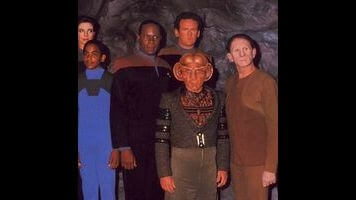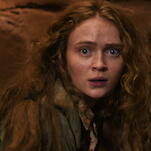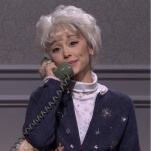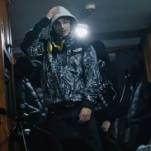Star Trek: Deep Space Nine: “Visionary”/“Distant Voices”

“Visionary” (season three, episode 17; originally aired 2/27/1995)
In which O’Brien meets O’Brien, and all hell breaks loose…
If you want to get metaphysical for a moment, the god of Star Trek is terrifyingly soothing. You can argue that there is no such entity, or that I’m mistaking authorial intent for the will of the divine, but I think in this case, any distinction between the two is largely meaningless. DS9 has its prophets (which are rational), but while those prophets can see through time, they rarely appear all that interested in controlling the outcome of events—that’s left up to the protagonists, and whatever benevolent force watches over all. Make no mistake, there has to be some kind of benevolent force at work here, or else everyone on the station should be hitting the Dabo tables every day for the rest of their lives. Sure, bad things happen to Sisko, O’Brien, Kira, and the rest all the time, but the way those things happen, and the number of times those seeming catastrophes wind up preventing far more serious damage down the line, is hard to ignore.
Take “Visionary.” (Gasp! Segue!) The episode begins mere moments after O’Brien was zapped with a mild case of radiation poisoning while doing routine maintenance work. According to Bashir, the injury is minimal, although he insists that O’Brien take some time off to recuperate. Which the chief begrudgingly does, setting up a dartboard in Quark’s and attempting (unsuccessfully) to convince Ferengi of the glories of the game. Then, suddenly, he finds himself standing across the promenade, watching himself have a conversation with Quark—something about Klingons wrecking the holosuites. As hallucinations go, this is decidedly unimpressive, as Bashir is quick to point out. (Man, these two are fun, aren’t they? It’s solid writing how their relationship has gone from antagonistic to clearly warm and friendly, without ever losing the basic dynamic established at the start of the series.) Only, it’s not a hallucination, as roughly five hours after the attack, Quark comes up to O’Brien to ask for a repair crew for the holosuites, and O’Brien looks over and sees himself, from the past, watching himself from the present. And then Quark sees the same thing. Something strange is going on.
It turns out O’Brien is time traveling, which, this being a science-fiction series, is probably not a stunning revelation. The rest of the episode has jumping from Point A to Point Q and back again, with little warning before each jump, and, at first, little explanation as to what’s happening to the chief. But while Bashir eventually makes the connection between the radiation exposure and some stray tetrion particles floating around the station, nobody points out the increasingly obvious: O’Brien’s jumps keep getting more and more story-relevant. At first, his ability to see what comes next means he can save himself from a nasty bruise when a fight breaks out in Quark’s, but later, he witnesses his own death not once, but twice—and as if that wasn’t enough, he also sees the destruction of the entire station. There’s never any justification for this (unless I missed it), and there doesn’t really need to be; this would be a boring, and eventually very, very depressing, episode if O’Brien’s jumps were to one of the random, inconsequential moments that make up roughly 99 percent of our lives. (The percentage is probably lower for a major character in an ongoing television series, admittedly.) But it’s hard to shake the feeling that something is guiding him. Sure, his second-to-last jump takes him to a point too late to actually understand what’s happening, but it gives him the tools necessary to save the station—albeit to do so at a shocking cost.
You could say that O’Brien’s malady (and surely Bashir must try and enter this one into the medical books) connects to what ultimately turns out to be the main crisis of the episode: The nefarious Romulans who, deciding that the Dominion is too big of a thread to withstand, are determined to destroy the wormhole, and DS9 along with it. See, the Romulans have a cloaked war bird circulating the station while a pair of Romulan investigators interrogate various members of DS9’s crew for information about their experiences in the Gamma Quadrant. The latter is a front, presumably, and when O’Brien sees the station exploding and the wormhole collapsing, he’s witnessing the culmination of the Romulans’ real plan. The irony is that the Romulans are the reason O’Brien is time-jumping in the first place. Their ships run on a quantum singularity that—well, there’s a lot of techno-babble, but the basic idea is that the particles from the war bird’s engines are reacting to the radiation in O’Brien’s system, or something along those lines, turning him into an intermittent DeLorean. It’s a clever way to connect the episode to the show’s larger themes—namely, the looming Dominion threat—as well as make sure the time-jumps don’t come across as completely random. Sure, there’s still the incredible coincidence of O’Brien getting zapped with just the right kind of radiation right before the Romulans showed up, but it’s more than we’d get in, say, an episode of Star Trek: The Next Generation that had a similar premise.
That’s worth looking at more closely, because it’s an indication of just how good the DS9 writers have gotten at balancing the demands of a Trek show (semi-magic sci-fi stuff, single episode storylines, geek bait) with its own ongoing needs. The idea that drives “Visionary” is fine, but what makes the episode so terrific is how that idea is integrated into the rest of the show, and all the various smart twists the writers find along the way. Like the way people start being ready for O’Brien to show up in the future; this makes perfect sense, and yet it’s startling when it happens and makes the whole concept seem just that much more real. There’s also the way the episode doesn’t waste any time trying to pretend that fate is unstoppable. When O’Brien sees his future self get killed by a beam from a wall panel, he, Sisko, and Odo investigate the panel, and though they don’t find anything immediately wrong, Sisko has Odo put a camera on the hallway, just to make sure. Eventually, Odo discovers a surveillance device beamed into the system that presumably had the built-in phaser security system which killed the future O’Brien, but no one makes a big deal out of this; nor does O’Brien find himself drawn back to the panel or forced to replay the future he’d witnessed by some intricate series of coincidences. In other words, in this episode, the future is very much changeable, and no one makes a big deal out of it. This may sound obvious, given the big twist at the end (you couldn’t tell this story if it turned out that the future was set in stone), but there’s a satisfying impression that the writers trust us to work this out for ourselves.
Then there’s the ending, which, thankfully, I saw unspoiled. In order to find out exactly what’s going to make the station explode in five hours, O’Brien decides he has to do another time-jump. Now that Bashir understands what’s happening to him, they’re able to manipulate the process in order to send him to a point in time before his last jump; unfortunately, the process requires O’Brien to undergo another radiation dose, and this one proves too much. Which is a shock. Bashir goes to great pains to warn O’Brien of the dangers of what he’s attempting before letting him go through the process, but it’s easy to interpret those warnings as just another way to generate suspense, and for much of O’Brien’s last jump, that’s how it plays out, as his growing weakness slows him and future O’Brien’s efforts to get to the bottom of what’s going on. But once they realize the truth about the Romulans, our O’Brien realizes he’s too ill to make the journey back. So he gives the future O’Brien the time-travel armband, and they swap places—which means, from now on, our O’Brien is actually future O’Brien.
Who was basically our O’Brien anyway, just at a different point in time, although I’m not sure why he was sleeping so comfortably knowing that the station was going to explode, except clearly he didn’t know because then—augh, time travel, it’s the worst. Anyway, that’s not what’s important. What’s important is that this is a major shift that doesn’t really have any significant impact on the rest of the show (that I know of), but still comes across as unsettling and sad. For the rest of his life, O’Brien’s going to feel a little off, like he walked into a movie just a few minutes late. He’ll get used to it, probably, and the chief is such a stolid, common-sense presence that I can’t imagine he’ll let the existential heebie-jeebies keep him down for long. But it’s just so odd. “Visionary” doesn’t do much dramatic heavy lifting—this is more purely fun than it is deeply felt—but it’s twisty and massively entertaining, giving us effective character moments for most of the cast, and ending in a way that seems happy—and is happy—but also kind of isn’t. There’s nothing quite like reaffirming and undermining the status quo at the same time.








































